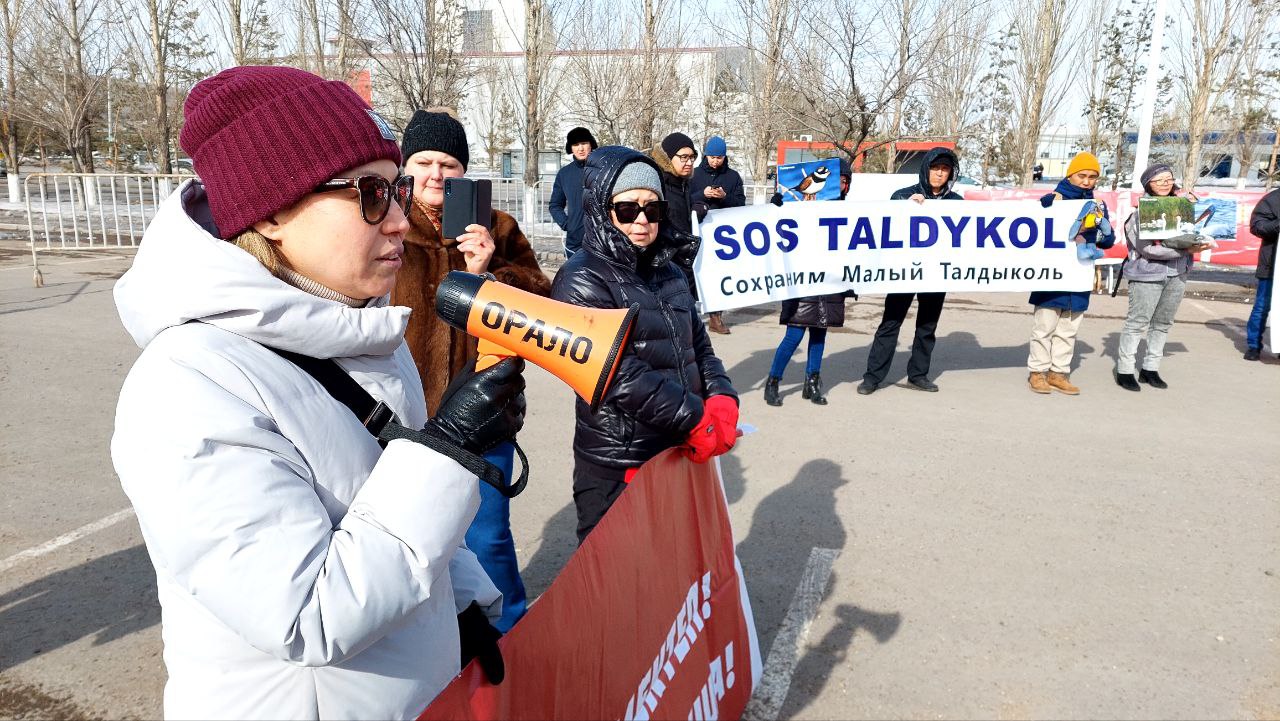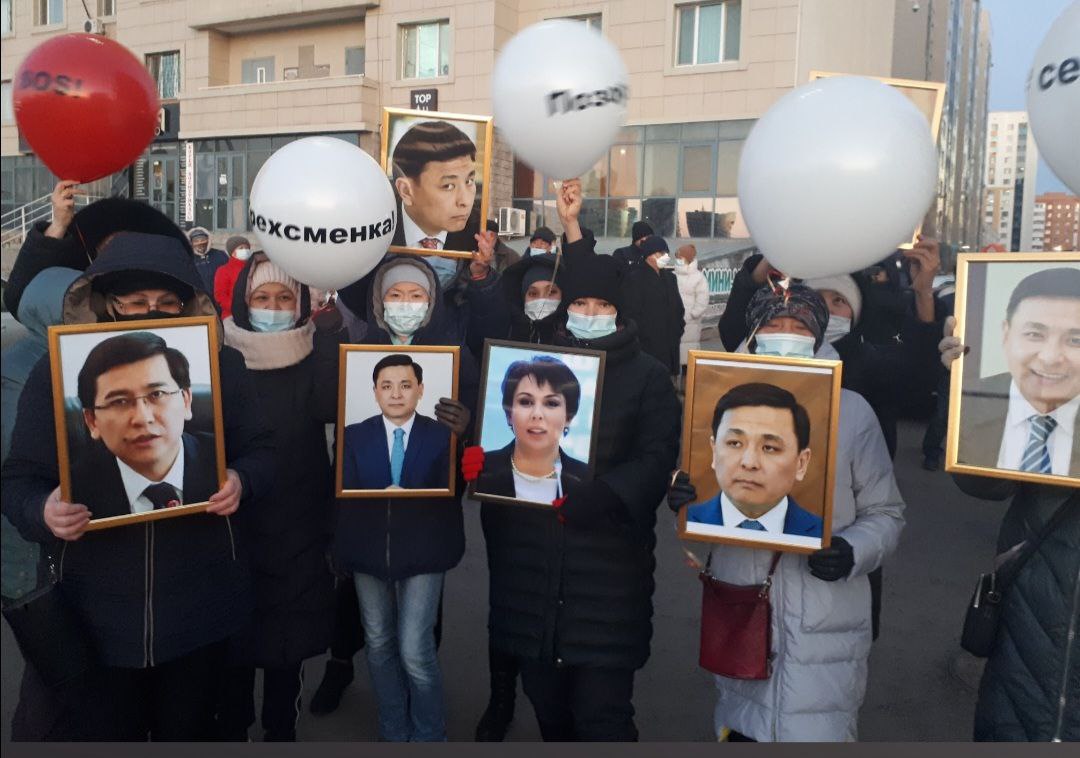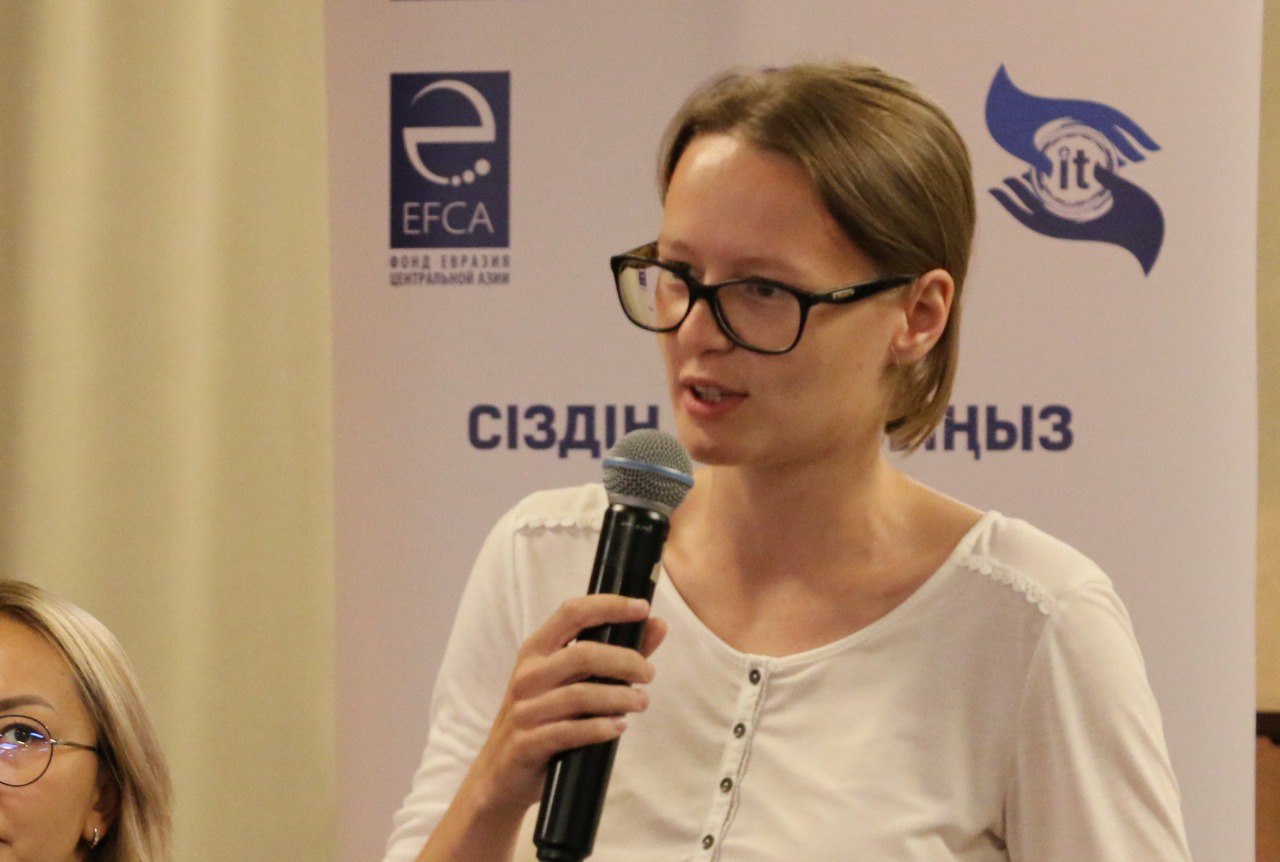The society of Kazakhstan is often blamed for immaturity. Authorities tend to call civil protests marginal, and blame people for dependency from time to time. However, urban activism that has been widespread in recent years in Astana has become the model of struggle for political participation in the city’s life and the ability of civic activists to promote public interests constructively despite difficult dialogue with authorities.
Who wants it most
Spring never comes on time in the capital of Kazakhstan. All March long city dwellers who were still wearing winter down coats were tormented by strong wind. The Saturday morning of March 4 on the left bank of Astana was uncrowded, the city of officials is asleep. Only local urban activists who received permit for the third protest against infill development – construction of new high-rise buildings in the building estate make the area ‘overcrowded’ and turn them into ‘humant hills’ (ant hills for humans) – did not sleep. Stepping over big swampy puddles, they hurry up towards the square near the city circus surrounded by police officers and their colleagues from security services in civilian clothes.
“’They’ will outnumber us,” activists say.
Protests against infill development are usually not very crowded. This time representatives of over a dozen of initiative groups struggling for social facilities – schools, kindergartens, polyclinics, squares – came to the protest. Otherwise, if they turn a blind eye to the activities of the city administration, who is willing to allot last plots of land in residential areas to developers, they can lose the above-mentioned facilities. Among protesters are eco activists of the SOS Taldykol movement, who tried to save the area of the Small Taldykol lakes from development. Authorities ignored the people. Lake water was drained and covered with earth. Now, high-rise buildings are rising in the place of the lakes.

“Since 2020, we have applied to court, met with the akimat, written two petitions to the president. In 2020, we spoke about the preservation of Small Taldykol, and now we want them to be restored because they continue to be destroyed despite the public outcry. Development did not stop for a day,” said Temirtas Iskakov, architect, participant of the SOS Taldykov movement.
What it was like before
Just three years ago, when first initiative groups struggling against infill development appeared in Astana, activists could not even imagine that they would be permitted to hold the rally. The architecture and development of the capital depended on the will of the first president Nazarbayev. Protests against actions of developers, whose CEOs were on the Forbes list, were not permitted by authorities. It was clear that the concept of the ‘Hearing state’ announced by Nazarbayev’s successor, President Tokayev, that was meant to establish relations between authorities and civil society did not work. It was impossible to keep silent about the catastrophic development of the capital. Astana almost stopped building social facilities. The shortage of schools led to three-shift study. Class size of 40 students became a norm, which deteriorated the quality of study.
“The problem is that officials do not want to hear about the problem of infill development. You recourse to the akimat, then to the presidential administration, and they again refer you to the akimat, and so forth. Only an outcry can draw some attention. But street protests, even authorised ones, are something extreme for urban residents. They all are scared of something,” said Aliya Beisenova, resident of Astana.
To avoid fines and detentions, people were holding air balloons in their hands, instead of posters, with signs and portraits of officials responsible for social well-being of residents.

“In my mind, even the new akim of Astana (Zhenis Kasymbek – Editor) does not fully understand where his jurisdiction begins and where it ends because development in Astana had long been under the jurisdiction of the first president of Kazakhstan, as we all perfectly know. The current state of affairs is unclear,” said Temirtas Iskakov, architect and civil activist.
Journalists, who are mostly dependant on the government information order, are still reluctant to cover the topic of infill development and its consequences. Moreover, one-sided materials discrediting protest movements can be often seen in press. Residents who were against the construction of the residential complex by BI Group near the most overcrowded three-shift school No. 59 of Astana were branded as “consumer extremists.”
“For three years of our struggle against infill development, we have seen various unsuccessful options of interaction with the media. There have been cases when a state channel arrived and filmed the report, but it was not allowed for broadcasting. Suppressing the problem leads to misunderstanding, impossibility of constructive dialogue because people shut down, but the feeling of protest does not go away,” said Laura Yeralina, civic activist.
Despite the propaganda and attempts to demonise the protesters in the media, people still organise themselves by means of social media. Accounts of activists and initiative groups on social media, where one can follow the situation and learn the position of civic activists on any conflict issues, help draw public attention and even counter fake news and defamation.
However, reporting events on social media can have risks sometimes. In June 2022, activist Saltanat Tashimova of Almaty, who streamed the civil protest online against infill development in her city, was detained for 15 days for participation in the unauthorised protest.
“Residents followed my advice and organised the meeting. I came there to film a video. State bodies did not know what to charge me with and charged me with the fact that I was not the resident of that district. But it’s not the reason for detaining a person for 15 days. Therefore (afterwards – Editor), I registered my network channel ‘Tashimova news’ in Telegram as a media. So, now I am protected. Developers are scared of public outcry. Unfortunately, it’s only outcry that helps us fight against lawlessness,” said Saltanat Tashimova.
The account of ecological movement SOS Taldykol on Instagram can be regarded as the independent media, which not only tells stories of struggle against developers and negotiations with authorities, but also refutes fake news and misleading information, implements educational projects, organised urban events to explain the significance of preservation and restoration of the lakes to people. Creative young people support the ecological movement. Architect Temirtas Iskakov organised a free training course “Steppe ecosystems in the city”, and in 2021 one of the most prominent art events was the performance by artists Askhat Akhmedyarov and Aigerim Ospan Baqsy Saryny (from Kazakh – shaman’s melody), when artists blocked the way to KamAZ trucks filled with ground on the artificially drained area of the lakes. Police detained Akhmedyarov and several ecoactivists for that.

Authorities did not want to allow urban activists to protest even after the January 2022 events, although state propaganda claimed that Tokayev’s ‘hearing state’ was working in reality. Over a dozen of initiative groups opposing infill development have established a non-governmental organisation ‘Menin Elim Dala’. Officials kept on rejecting requests for protests under various excuses. In August 2022, members of ‘Menin Elim Dala’ filed a lawsuit against the akimat and thus obtained permission for the protest. Anna Klimchenko, researcher of PaperLab centre, believes that this event is extraordinary in itself. Authorities cannot fully ignore urban activists as before after such decisive steps.

Who’s in urban activism in Astana
Most of the members of initiative groups are representatives of intellectual professions with vast experience both in public and in private sector. These people are able to see far-reaching consequences of unregulated construction of high-rise buildings that exceed two years – from deterioration of the environment and health of residents to the growing inequality, crime rate, cultural and intellectual degradation of the society. The metropolitan urban activism has caught the attention of sociologists, who made up their average image.
According to researcher Anna Klimchenko, these are mainly residents of modern residential complexes, who work in the sphere of education or are medical workers, engineers, entrepreneurs, and some of them are retired. Their professional experience is not related to activism, they practice it in their free time. Their desire to defend their position is so strong that they learn new things on their own: they go into legal subtleties to win another trial, learn the fundamentals of social media marketing.“If we look at political activists of Kazakhstan, they do not establish entities because of fear to draw unwanted attention of authorities and fear of restrictions that can potentially arise as a result of such attention. Meanwhile, establishment of the public association ‘Menin Elim Dala’ has marked the launch of movement against development,” Anna Klimchenko said.
Urban activists have a lot of positive cases, when they have managed to defend construction of schools, parks, polyclinics. However, it is too early to speak about their absolute victory. Every change of the situation in favour of residents follows great efforts and numerous negotiations, meetings of residents, and sometimes trials.
According to activist Laura Yeralina, officials in akimats are scared of responsibility for changing the common system of public administration. Civil movements somewhat help those who really want to contribute to community development.
“I have a feeling that the system has fallen into patterns. Even those who are newcomers to the system are swallowed up by the system and work following the old patterns. People have a fear of losing a job and a fear of responsibility. We cannot say that everything is bad because there are some competent employees in akimats, yet no man is an island. When people join together to protect public interests, which are ultimately the interests of the state, the nation, the future of Kazakhstan, it would be easier for pioneers in state bodies to make decisions,” Laura Yeralina said.
Civic activists want institutional changes. They have requested public hearings on development projects, which would help bring decision-making on development out of the shadows, for three years already. Professional city planners, engineers and lawyers of ‘Menin Elim Dala’ have even developed appropriate mechanisms that can be put into practice. But authorities ignore them.
Urban activism researchers believe that no matter how official authorities try to spread the discourse about the civil society of Kazakhstan paying no interest to making socially significant decisions, the experience of ‘Menin Elim Dala’ demonstrates the opposite. They emphasise the maturity of the active civil society.
Without support and with burnout
The protests against infill development in Astana do not gather many participants, yet draw attention of other initiative groups that want to have a look at the experience of activists of ‘Menin Elim Dala’.
“If you really want to achieve something, you need to get together. You also need to involve those who somehow support your position. The young people are allergic to the words ‘party’ or ‘politics’, they say, ‘We are independent, we won’t work with parties, etc.’ But how are they going to change laws then?” Ural Koyanbayev, chief of ‘Menin Elim Dala’, said.
Civic activists believe that inactivity of majority of urban residents has caused serious problems in the city. Because of infill development, Astana lacks not only social facilities, but also thermal power. New residential complexes with autonomous heating have appeared, which aggravate the serious environmental situation in the city, whose population exceeds 1.2 million people. This year, water shortage has made authorities arrive at a decision to decrease pressure in public water supply, while in some residential complexes authorities turn off water for a few hours per day. President Tokayev has recently promoted the akim of the capital, Altai Kulginov, to the position of a vice prime minister, with whom urban activists have tried to establish a constructive dialogue for all these years.
Researchers speak about the burnout of urban activists because not every initiative group can achieve a positive decision on development in their area.

“Those who have managed to do it say that the secret of their success was their prompt reaction, for example, before the fence was built around the site of the future high-rise building or at the stage of foundation excavation. Activists themselves specify burnout as one of the main problems in cases when their activity does not yield results. However, there are opposite situations, when residents of any given residential complex win their case in court and stop being interested in further struggle of other initiative groups,” Anna Klimchenko said.
Main photo: Anar Bekbasova

